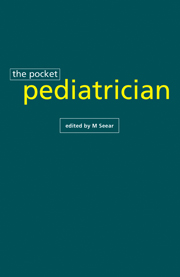Book contents
- Frontmatter
- Contents
- Analytical contents list
- Preface
- 1 Cardiology
- 2 Death and dying
- 3 Emergencies
- 4 Endocrinology
- 5 Fluids and electrolytes
- 6 Gastroenterology
- 7 General surgery
- 8 Health care ethics
- 9 Hematology
- 10 Infectious diseases
- 11 Intensive care and continuous infusion drugs
- 12 Medical genetics
- 13 Neonatology and neonatal drug dosage guidelines
- 14 Neurology
- 15 Nutrition
- 16 Oncology
- 17 Pediatric transport
- 18 Pharmacology and drug dosage guidelines
- 19 Renal
- 20 Resident fellow training
- 21 Respirology
- 22 Rheumatology
- 23 Transfusion medicine
- 24 Appendix
- Index
11 - Intensive care and continuous infusion drugs
Published online by Cambridge University Press: 01 February 2010
- Frontmatter
- Contents
- Analytical contents list
- Preface
- 1 Cardiology
- 2 Death and dying
- 3 Emergencies
- 4 Endocrinology
- 5 Fluids and electrolytes
- 6 Gastroenterology
- 7 General surgery
- 8 Health care ethics
- 9 Hematology
- 10 Infectious diseases
- 11 Intensive care and continuous infusion drugs
- 12 Medical genetics
- 13 Neonatology and neonatal drug dosage guidelines
- 14 Neurology
- 15 Nutrition
- 16 Oncology
- 17 Pediatric transport
- 18 Pharmacology and drug dosage guidelines
- 19 Renal
- 20 Resident fellow training
- 21 Respirology
- 22 Rheumatology
- 23 Transfusion medicine
- 24 Appendix
- Index
Summary
INTRODUCTION
Intensive medical care for critically ill children is a relatively recent development that can only be afforded by rich countries. Even the large units take less than 1,500 patients a year with an average mortality of about 5%. Most of the survivors have a very good quality of life. In global terms, this does not even scratch the surface; UNICEF's last estimate for 1994 was 12.5 million avoidable deaths of children < 5 years of age. Most of these children simply required food, clean water and immunization. Community medicine cannot match the Intensive Care Unit (ICU) for drama and fascinating gadgets that go beep, but the principles of primary health care have saved millions more lives than all the ICU's together will ever achieve.
Pediatric intensive care is still a new discipline. It borrows from the slightly older literature of adult and neonatal intensive care, and there is a growing body of relevant research. However, many clinical decisions are still made on the basis of little more than common sense. Consequently, a detailed knowledge of pathophysiology is vital for any physician working with critically ill children.
Care of critically ill children is frequently very rewarding; many of the children recover well because they are usually free of underlying chronic illness. It must be stressed, however, that changes in clinical condition happen very quickly and require an appropriately prompt response from the attending physician to avert a disaster.
The following chapter will focus on the four areas that keep the ICU full: cardiac disease, respiratory disease, central nervous system disease and major trauma.
- Type
- Chapter
- Information
- The Pocket PediatricianThe BC Children's Hospital Manual, pp. 198 - 253Publisher: Cambridge University PressPrint publication year: 1996

